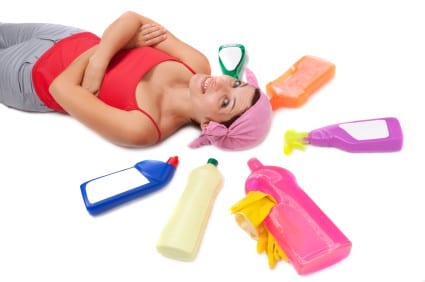“Eco-friendly” is a big-time buzzword in the home-cleaning aisles at nearly every store. Specialty companies offer cleaning supplies of all sorts, often in distinctive packaging and fragrances. Even common household names are getting in on the green trend and marketing their own eco-friendly cleaning products. Eco-friendly cleaners often come with a higher price tag, but you may wonder whether they can make a difference in your home and for the environment.
“Eco-friendly” is a big-time buzzword in the home-cleaning aisles at nearly every store. Specialty companies offer cleaning supplies of all sorts, often in distinctive packaging and fragrances. Even common household names are getting in on the green trend and marketing their own eco-friendly cleaning products. Eco-friendly cleaners often come with a higher price tag, but you may wonder whether they can make a difference in your home and for the environment.
Definitions and Certifications
You will probably see such terms as “green,” “eco-friendly” and “biodegradable” on many cleaning products. The hope is that these products are nontoxic, noncorrosive and noncarcinogenic. The reality is that these terms are advertising buzzwords and mean little or nothing. The Environmental Protection Agency offers an eco-friendly certification called Design for the Environment or DtE. This certification does offer you some assurances that you are purchasing an eco-friendly product. You may also want to look for “Green Seal” certification for more rigorous eco-friendly standards. Certification is voluntary, so some eco-friendly cleaning products may carry no certifications at all but are still safe and effective.
Ingredients
Regular household cleaners rely upon such chemicals as chlorine bleach and ammonia to clean and disinfect your home. Although these products do clean effectively, they are not good for the environment and can even pose health risks to humans and animals. Eco-friendly cleaners rely upon citrus-based solvents, vinegar, essential oils and natural abrasives to clean and disinfect without harmful chemicals.
Function
Eco-friendly cleaners often come with a higher price tag, but you may worry that they will not work well. On the whole, rest assured that they are effective. Buyers should keep in mind that some eco-friendly cleaners may require more elbow grease than standard household cleaners, and they should look for the right cleaner for the job. Good quality cleaning supplies, including mops and scrub brushes, will improve the effectiveness of your cleaners.
Eco-Friendly Housekeeping
If you want to replace your traditional household cleaners, you will find that many stores, even your local discount store, have a number of eco-friendly options on the shelves. At the bare minimum, you should have a good all-purpose cleaner and a good glass cleaner. You may also want specialty toilet-bowl or tub-and-tile cleaner to make cleaning easier. Look for minimal packaging or cleaners that can be refilled from concentrate to cut down on packaging waste.
Eco-Friendly Recipes
If you would like to make the switch to eco-friendly cleaners, one of the best options is simply to make your own. You can clean most things in your home with vinegar, lemon juice, a basic liquid soap, borax and baking soda. Combine 1 tsp. liquid soap, a squeeze of lemon juice, 1 tsp. borax and 1 qt. warm water in a large spray bottle to create an easy-to-use and effective general household cleaner. Baking soda can be mixed with liquid soap to form an excellent tub-and-tile cleaner. You can even combine borax, washing soda and grated bar soap to make your own laundry detergent.





